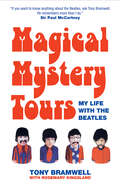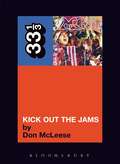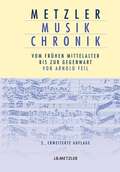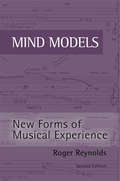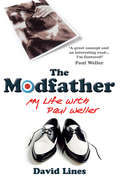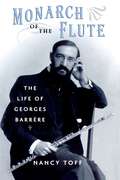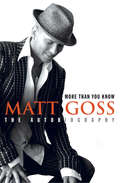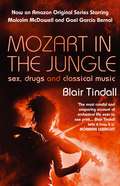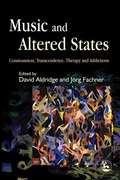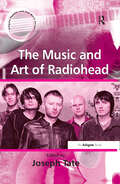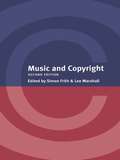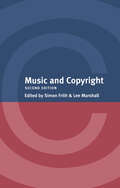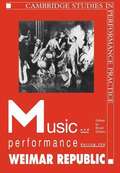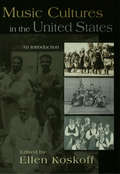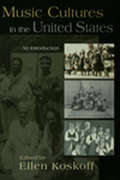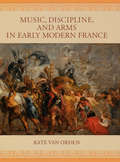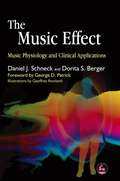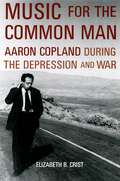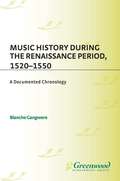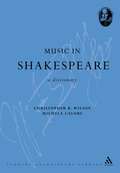- Table View
- List View
Magical Mystery Tours: My Life With The Beatles
by Tony BramwellTony Bramwell's remarkable life with The Beatles began in a post-war Liverpool suburb where he was childhood friends with John, Paul and George. By the time he unexpectedly ran into George Harrison on top of a bus, Tony was well into a life story absolutely unlike any other.
MC5's Kick Out the Jams (33 1/3)
by Don McLeeseWhen the Motor City 5 stormed the stage, the band combined the kinetic flash of James Brown on acid with the raw musical dynamics of the Who gone berserk. It's a unique band that can land itself on the cover of Rolling Stone a month before the release of its debut album and then be booted from its record contract just a few months later. Rock had never before seen the likes of the MC5 and never will again. Many of us who were floored by the 5 in concert were convinced that this was the most transcendently pulverizing rock we would ever experience, while many more who heard or read about the band dismissed the 5 as a caricature, a fraud, White Panther bozos play-acting at revolution. There was always plenty of humor to the 5-visionary knuckleheads-though the question was whether they were in on the joke. Frequently ridiculed during their short career, they've since been hailed as a primal influence on everything from punk to metal to Rage Against the Machine to the Detroit populist resurgence of the White Stripes, Kid Rock and Eminem.
Metzler Musik Chronik: Vom frühen Mittelalter bis zur Gegenwart
by Arnold Feil1.000 musikalische Werke vom frühen Mittelalter bis zur Gegenwart. Die Chronik verbindet die Vorzüge einer Musikgeschichte mit denen eines Werklexikons. Die zweite Auflage wurde um 200 Artikel zur Musik der Gegenwart von 1950 bis heute erweitert.
Mind Models
by Roger ReynoldsThis new edition of Mind Models reintroduces and renews a classic work on 20th century composition, one that has remained relevant for over a quarter century -- and should remain a central reading for decades to come.
Mind Models
by Roger ReynoldsThis new edition of Mind Models reintroduces and renews a classic work on 20th century composition, one that has remained relevant for over a quarter century -- and should remain a central reading for decades to come.
The Modfather: My Life with Paul Weller
by David LinesWhen David Lines first heard This is the Modern World by The Jam, it sparked off a love affair that continues to this day. Paul Weller became the blueprint for David's life, and he followed his music and his style with the fervour of a truly devoted fan - to the bemusement of his long-suffering family. At once disarmingly candid and hilariously funny, this is the story of what it means to have a hero, its pleasures and pitfalls. Illustrating his memoir with landmark songs from The Jam and The Style Council, David maps out the occasionally bizarre events in the life of an obsessive fan and wannabe writer.From Player's Navy Cut to Gitanes, boating blazers to cashmere sweaters, The Modfather is about acquiring style, finding substance and living life with Paul Weller.
Monarch of the Flute: The Life of Georges Barrère
by Nancy ToffGeorges Barrère (1876-1944) holds a preeminent place in the history of American flute playing. Best known for two of the landmark works that were written for him--the Poem of Charles Tomlinson Griffes and Density 21.5 by Edgard Varèse--he was the most prominent early exemplar of the Paris Conservatoire tradition in the United States and set a new standard for American woodwind performance. Barrère's story is a musical tale of two cities, and this book uses his life as a window onto musical life in Belle Epoque Paris and twentieth-century New York. Recurrent themes are the interactions of composers and performers; the promotion of new music; the management, personnel, and repertoire of symphony orchestras; the economic and social status of the orchestral and solo musician, including the increasing power of musicians' unions; the role of patronage, particularly women patrons; and the growth of chamber music as a professional performance medium. A student of Paul Taffanel at the Paris Conservatoire, by age eighteen Barrère played in the premiere of Debussy's Prelude to the Afternoon of a Faun. He went on to become solo flutist of the Concerts Colonne and to found the Sociètè Moderne d'Instruments á Vent, a pioneering woodwind ensemble that premiered sixty-one works by forty composers in its first ten years. Invited by Walter Damrosch to become principal flute of the New York Symphony in 1905, he founded the woodwind department at the Institute of Musical Art (later Juilliard). His many ensembles toured the United States, building new audiences for chamber music and promoting French repertoire as well as new American music. Toff narrates Barrère's relationships with the finest musicians and artists of his day, among them Isadora Duncan, Yvette Guilbert, André Caplet, Paul Hindemith, Albert Roussel, Wallingford Riegger, and Henry Brant. The appendices of the book, which list Barrère's 170 premieres and the 50 works dedicated to him, are a resource for a new generation of performers. Based on extensive archival research and oral histories in both France and the United States, this is the first biography of Barrère.
More Than You Know
by Matt GossMatt Goss recounts his unbelievable life story in emotional detail. From financially deprived but emotionally rich beginnings, Matt sees his fortunes literally turned upside-down, with all the fame, glamour and money he could hope for violently snatched away from him.
Mozart in the Jungle: Sex, Drugs and Classical Music
by Blair TindallNow a major Amazon.com TV series starring Gabriel Garcia Bernal.From her debut recital at Carnegie Hall to performing with the orchestras of Les Miserables and Miss Saigon, oboist Blair Tindall has been playing classical music professionally for over twenty-five years. She's also lived the secret life of musicians who survive hand to mouth, trading sex and drugs for low-paying gigs and the promise of winning a rare symphony position or a lucrative solo recording contract. In Mozart in the Jungle, Tindall describes her graduation from the North Carolina School of the Arts to the backbiting New York classical music scene, a world where Tindall and her fellow classical musicians often play drunk, high, or hopelessly hung-over, live in decrepit apartments, and perform in hazardous conditions. (In the cramped confines of a Broadway pit, the decibel level of one instrument is equal to the sound of a chain saw.)Mozart in the Jungle offers a stark contrast between the rarefied experiences of overpaid classical musician superstars and those of the working-class musicians. For lovers of classical music, Mozart in the Jungle is the first true, behind-the-scenes look at what goes on backstage and in the Broadway pit.
Music and Altered States: Consciousness, Transcendence, Therapy and Addictions
by Dalia Cohen David Aldridge Joerg Fachner Lucanne Magill Tsvia HoreshThis international collection examines the opportunities for using music-induced states of altered consciousness to promote physical and mental healing, treat substance dependence, and in spiritual and palliative care. The contributors describe the successful use of altered states and their therapeutic potential, providing examples from different cultures and clinical, therapeutic and spiritual settings. Their observations cover a wide range of music types capable of inducing altered states, including polyrhythmic music, monotonous drumming, Western pop, and Arab musical schemata, complemented by theoretical and clinical approaches to applications in music therapy. This book will be a useful reference for practising music therapists, musicologists, and ethnomusicologists, students and academics in the field.
Music and Altered States: Consciousness, Transcendence, Therapy and Addictions (PDF)
by Dalia Cohen David Aldridge Joerg Fachner Lucanne Magill Tsvia HoreshThis international collection examines the opportunities for using music-induced states of altered consciousness to promote physical and mental healing, treat substance dependence, and in spiritual and palliative care. The contributors describe the successful use of altered states and their therapeutic potential, providing examples from different cultures and clinical, therapeutic and spiritual settings. Their observations cover a wide range of music types capable of inducing altered states, including polyrhythmic music, monotonous drumming, Western pop, and Arab musical schemata, complemented by theoretical and clinical approaches to applications in music therapy. This book will be a useful reference for practising music therapists, musicologists, and ethnomusicologists, students and academics in the field.
The Music and Art of Radiohead
The Music and Art of Radiohead provides compelling close readings of the English band's music, lyrics, album cover art and music videos as well as critical commentary on interviews, reviews and the documentary film Meeting People is Easy. Established and emerging academic scholars engage with Radiohead's music and art via concerns of broader implication to contemporary cultural studies. Topics range from the band's various musical and multivalent social contexts to their contested situation within a global market economy; from asking the question, 'how free is art?' to considering the band's musical influences and radical sonic explorations. Together, the essays form a comprehensive discussion of Radiohead's entire oeuvre, from Pablo Honey to Hail to the Thief, with a special focus on the critically acclaimed best-selling albums Kid A and Amnesiac.
The Music and Art of Radiohead
by Joseph TateThe Music and Art of Radiohead provides compelling close readings of the English band's music, lyrics, album cover art and music videos as well as critical commentary on interviews, reviews and the documentary film Meeting People is Easy. Established and emerging academic scholars engage with Radiohead's music and art via concerns of broader implication to contemporary cultural studies. Topics range from the band's various musical and multivalent social contexts to their contested situation within a global market economy; from asking the question, 'how free is art?' to considering the band's musical influences and radical sonic explorations. Together, the essays form a comprehensive discussion of Radiohead's entire oeuvre, from Pablo Honey to Hail to the Thief, with a special focus on the critically acclaimed best-selling albums Kid A and Amnesiac.
Music and Copyright
by Lee Marshall Simon Frith"First Published in 2004, Routledge is an imprint of Taylor & Francis, an informa company."
Music and Copyright: Romanticism And Copyright In The Music Industry (Law And Society Ser.)
by Simon Frith Lee Marshall"First Published in 2004, Routledge is an imprint of Taylor & Francis, an informa company."
Music And Performance During The Weimar Republic: (pdf) (Cambridge Studies In Performance Practice Ser. #Series Number 3)
by Bryan Randolph GilliamFollowing the collapse of the Wilhelmine Empire in Germany, a new generation of artists found a fresh environment where they might flourish. Their optimism was accompanied by an equally powerful distrust of the immediate past, for post-romanticism - and ultimately expressionism - served as symbols of a bygone era. Composers, performers, and audiences alike sought to negate their recent past in various ways: by affirming modern technology (electronic or mechanical music, sound recordings, radio, and film), exploring music of a more remote past (principally Baroque music), and celebrating popular music (particularly jazz). The essays contained in this volume address these fundamental themes. Examining the way in which German music was performed, staged, programmed, and received in the 1920s, they not only offer deeper insights into Weimar culture itself but shed light on our contemporary musical world.
Music Cultures in the United States: An Introduction
by Ellen KoskoffMusic Cultures in the United States is a basic textbook for an Introduction to American Music course. Taking a new, fresh approach to the study of American music, it is divided into three parts. In the first part, historical, social, and cultural issues are discussed, including how music history is studied; issues of musical and social identity; and institutions and processes affecting music in the U.S. The heart of the book is devoted to American musical cultures: American Indian; European; African American; Latin American; and Asian American. Each cultural section has a basic introductory article, followed by case studies of specific musical cultures. Finally, global musics are addressed, including Classical Musics and Popular Musics, as they have been performed in the U.S..Each article is written by an expert in the field, offering in-depth, knowledgeable, yet accessible writing for the student. The accompanying CD offers musical examples tied to each article. Pedagogic material includes chapter overviews, questions for study, and a chronoloogy of key musical events in American music and definitions in the margins.
Music Cultures in the United States: An Introduction
by Ellen KoskoffMusic Cultures in the United States is a basic textbook for an Introduction to American Music course. Taking a new, fresh approach to the study of American music, it is divided into three parts. In the first part, historical, social, and cultural issues are discussed, including how music history is studied; issues of musical and social identity; and institutions and processes affecting music in the U.S. The heart of the book is devoted to American musical cultures: American Indian; European; African American; Latin American; and Asian American. Each cultural section has a basic introductory article, followed by case studies of specific musical cultures. Finally, global musics are addressed, including Classical Musics and Popular Musics, as they have been performed in the U.S..Each article is written by an expert in the field, offering in-depth, knowledgeable, yet accessible writing for the student. The accompanying CD offers musical examples tied to each article. Pedagogic material includes chapter overviews, questions for study, and a chronoloogy of key musical events in American music and definitions in the margins.
Music, Discipline, and Arms in Early Modern France
by Kate van OrdenIn this groundbreaking new study, Kate van Orden examines noble education in the arts to show how music contributed to cultural and social transformation in early modern French society. She constructs a fresh account of music's importance in promoting the absolutism that the French monarchy would fully embrace under Louis XIV, uncovering many hitherto unpublished ballets and royal ceremonial performances. The great pressure on French noblemen to take up the life of the warrior gave rise to bellicose art forms such as sword dances and equestrian ballets. Far from being construed as effeminizing, such combinations of music and the martial arts were at once refined and masculine-a perfect way to display military prowess. The incursion of music into riding schools and infantry drills contributed materially to disciplinary order, enabling the larger and more effective armies of the seventeenth century. This book is a history of the development of these musical spheres and how they brought forth new cultural priorities of civility, military discipline, and political harmony. Music, Discipline, and Arms in Early Modern France effectively illustrates the seminal role music played in mediating between the cultural spheres of letters and arms.
Music, Discipline, and Arms in Early Modern France
by Kate van OrdenIn this groundbreaking new study, Kate van Orden examines noble education in the arts to show how music contributed to cultural and social transformation in early modern French society. She constructs a fresh account of music's importance in promoting the absolutism that the French monarchy would fully embrace under Louis XIV, uncovering many hitherto unpublished ballets and royal ceremonial performances. The great pressure on French noblemen to take up the life of the warrior gave rise to bellicose art forms such as sword dances and equestrian ballets. Far from being construed as effeminizing, such combinations of music and the martial arts were at once refined and masculine-a perfect way to display military prowess. The incursion of music into riding schools and infantry drills contributed materially to disciplinary order, enabling the larger and more effective armies of the seventeenth century. This book is a history of the development of these musical spheres and how they brought forth new cultural priorities of civility, military discipline, and political harmony. Music, Discipline, and Arms in Early Modern France effectively illustrates the seminal role music played in mediating between the cultural spheres of letters and arms.
The Music Effect: Music Physiology and Clinical Applications
by Daniel J. Schneck Dorita S. BergerMusic is well known to have a significant effect on physiology and is widely used as an effective therapeutic tool in stress and pain management, rehabilitation, and behavior modification, but its effects are not well understood. This book explains what 'music' is, how it is processed by and affects the body, and how it can be applied in a range of physiological and psychological conditions. Rhythm, melody, timbre, harmony, dynamics, and form, and their effects on the body are explored in detail, helping practitioners create effective therapy interventions that complement other treatment systems. Case studies and evidence from research and practice show how music therapy can benefit people with autistic spectrum disorders, Down syndrome, schizophrenia, and sensory difficulties, among other conditions. The Music Effect is an essential resource for music therapists, clinicians, educators and anyone with an interest in holistic therapy.
The Music Effect: Music Physiology and Clinical Applications (PDF)
by Daniel J. Schneck Dorita S. BergerMusic is well known to have a significant effect on physiology and is widely used as an effective therapeutic tool in stress and pain management, rehabilitation, and behavior modification, but its effects are not well understood. This book explains what 'music' is, how it is processed by and affects the body, and how it can be applied in a range of physiological and psychological conditions. Rhythm, melody, timbre, harmony, dynamics, and form, and their effects on the body are explored in detail, helping practitioners create effective therapy interventions that complement other treatment systems. Case studies and evidence from research and practice show how music therapy can benefit people with autistic spectrum disorders, Down syndrome, schizophrenia, and sensory difficulties, among other conditions. The Music Effect is an essential resource for music therapists, clinicians, educators and anyone with an interest in holistic therapy.
Music for the Common Man: Aaron Copland during the Depression and War
by Elizabeth B. CristIn the 1930s, Aaron Copland began to write in an accessible style he described as "imposed simplicity." Works like El Salón México, Billy the Kid, Lincoln Portrait, and Appalachian Spring feature a tuneful idiom that brought the composer unprecedented popular success and came to define an American sound. Yet the cultural substance of that sound--the social and political perspective that might be heard within these familiar pieces--has until now been largely overlooked. While it has long been acknowledged that Copland subscribed to leftwing ideals, Music for the Common Man is the first sustained attempt to understand some of Copland's best-known music in the context of leftwing social, political, and cultural currents of the Great Depression and Second World War. Musicologist Elizabeth Crist argues that Copland's politics never merely accorded with mainstream New Deal liberalism, wartime patriotism, and Communist Party aesthetic policy, but advanced a progressive vision of American society and culture. Copland's music can be heard to accord with the political tenets of progressivism in the 1930s and '40s, including a fundamental sensitivity toward those less fortunate, support of multiethnic pluralism, belief in social democracy, and faith that America's past could be put in service of a better future. Crist explores how his works wrestle with the political complexities and cultural contradictions of the era by investing symbols of America--the West, folk song, patriotism, or the people--with progressive social ideals. Much as been written on the relationship between politics and art in the 1930s and '40s, but very little on concert music of the era. Music for the Common Man offers fresh insights on familiar pieces and the political context in which they emerged.
Music History During the Renaissance Period, 1520-1550: A Documented Chronology (Music Reference Collection)
by Blanche M. GangwereThis annotated chronology of western music is the third in a series of outlines on the history of music in western civilization. It contains a 120-page annotated bibliography, followed by a detailed, documented outline that is divided into ten chapters. Each chapter is written in chronological order with every line being documented by means of abbreviations that refer to the annotated bibliography. There are short biographies of the theorists and detailed discussions of their works. The information on music is organized by classes of music rather than by composer. Also included are lists of manuscripts with descriptions of their contents and notations as to where they may be found. The material for the outline has been taken from primary and secondary sources along with articles from periodicals.Like the other two volumes in this series, Music History from the Late Roman through the Gothic Periods, 313-1425 and Music History During the Renaissance Period, 1425-1520, this volume will be an important research tool for anyone interested in music history.
Music in Shakespeare: A Dictionary (Continuum Shakespeare Dictionaries)
by Christopher R. Wilson Michela CaloreMusical references, allusions to music, and music stage directions abound in Shakespeare, ranging from simple trumpet flourishes to sophisticated, philosophical allegory. Music in Shakespeare: A Dictionary identifies all musical terms found in the Shakespeare canon. An A-Z of over 300 entries includes a definition of each musical term in its historical and theoretical context, and explores the extent of Shakespeare's use of musical imagery across the full range of his dramatic and poetic work. Music in Shakespeare also analyses the usage of musical instruments and sound effects on the Shakespearean stage, providing descriptions of the instruments employed in the Elizabethan and Jacobean theatres. This is a comprehensive reference guide for scholars and students with interests ranging from the thematic and allegorical relevance of music in Shakespeare's works to the history of performance. It is also aimed at the growing number of directors and actors concerned with recovering the staging conditions of the early modern theatre.
